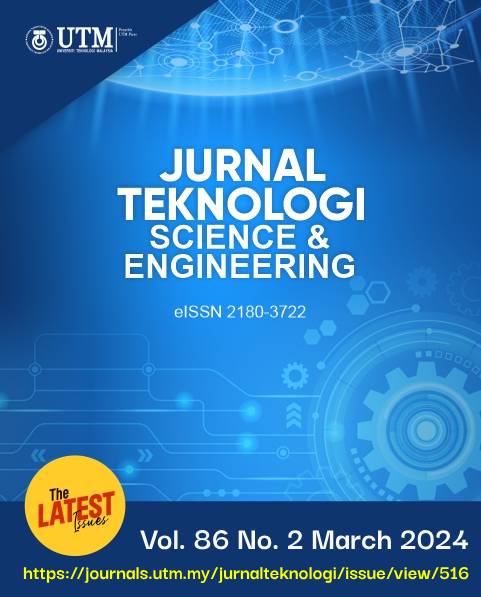PROTEIN INTERACTION STUDIES OF CROSS-LINKED ENDOLEVANASE AGGREGATES FROM BACILLUS LEHENSIS G1
DOI:
https://doi.org/10.11113/jurnalteknologi.v86.20888Keywords:
Endolevanase, enzyme immobilization, cross-linked enzyme aggregates, macromolecular cross-linkers, computational analysisAbstract
The efficiency of cross-linked enzyme aggregates (CLEAs) is mainly affected by the strength and binding site of the formed linkages between the enzyme and cross-linker. Therefore, this study investigated the impact of different macromolecular cross-linkers on various functional groups, their binding energy, and intermolecular interaction in generating CLEAs of endolevanase from Bacillus lehensis G1 (rlevblg1), through the combination of computational and experimental analysis. Due to the distanced bonding of dextran from the active site, rlevblg1 cross-linked with dextran (rlevblg1-dex-CLEAs) exhibited the highest binding affinity (− 7.1 kcal/mol) and activity recovery compared to six other cross-linkers. Thus, the role of computational cross-linker screening is confirmed as a crucial step to predict strong attachment and construct efficient CLEAs.
References
Sheldon, R. A. 2011. Characteristic Features and Biotechnological Applications of Cross-linked Enzyme Aggregates (CLEAs). Applied Microbiology and Biotechnology. 92(3): 467-477.
DOI: https://doi.org/10.1007/s00253-011-3554-2.
Cui, J. d., et al. 2014. Hybrid Magnetic Cross-linked Enzyme Aggregates of Phenylalanine Ammonia Lyase from Rhodotorula glutinis. PLoS One. 9(5): e97221.
Doi: https://doi.org/10.1371/journal.pone.0097221.
Zerva, A., C. Pentari, and E. Topakas. 2020. Crosslinked Enzyme Aggregates (CLEAs) of Laccases from Pleurotus Citrinopileatus Induced in Olive Oil Mill Wastewater (OOMW). Molecules. 25(9): 2221.
Doi: https://doi.org/10.3390/molecules25092221.
Matijošytė, I., et al. 2010. Preparation and Use of Cross-linked Enzyme Aggregates (CLEAs) of Laccases. Journal of Molecular Catalysis B: Enzymatic. 62(2): 142-148.
Doi: https://doi.org/10.1016/j.molcatb.2009.09.019.
Sheldon, R., R. Schoevaart, and L. Van Langen. 2005. Cross-linked Enzyme Aggregates (CLEAs): A Novel and Versatile Method for Enzyme Immobilization (A Review). Biocatalysis and Biotransformation. 23(3-4): 141-147.
Doi: https://doi.org/10.1080/10242420500183378.
Nawawi, N. N., et al. 2020. A Porous-cross Linked Enzyme Aggregates of Maltogenic Amylase from Bacillus lehensis G1: Robust Biocatalyst with Improved Stability and Substrate Diffusion. International Journal of Biological Macromolecules. 148: 1222-1231.
Doi: https://doi.org/10.1016/j.ijbiomac.2019.10.101.
Talekar, S., et al. 2014. Pectin Cross-linked Enzyme Aggregates (pectin-CLEAs) of Glucoamylase. RSC Advances. 4(103): 59444-59453.
Doi: https://doi.org/10.1039/C4RA09552A.
Zhen, Q., et al. 2013. Preparation of β-mannanase CLEAs using Macromolecular Cross-linkers. Catalysis Science & Technology. 3(8): 1937-1941.
Doi: https://doi.org/10.1039/c3cy20886a.
Mateo, C., et al. 2004. A New, Mild Cross‐linking Methodology to Prepare Cross‐linked Enzyme Aggregates. Biotechnology and Bioengineering. 86(3): 273-276.
Doi: https://doi.org/10.1002/bit.20033.
Nadar, S. S., et al. 2016. Macromolecular Cross-linked Enzyme Aggregates (M-CLEAs) of α-amylase. International Journal of Biological Macromolecules. 84: 69-78.
Doi: https://doi.org/10.1016/j.ijbiomac.2015.11.082.
Jailani, N., et al. (2022). Cross-linked Cyclodextrin Glucanotransferase Aggregates from Bacillus lehensis G1 for Cyclodextrin Production: Molecular Modeling, Developmental, Physicochemical, Kinetic and Thermodynamic Properties. International Journal of Biological Macromolecules.
Doi: https://doi.org/10.1016/j.ijbiomac.2022.05.170.
Fan, J., A. Fu, and L. Zhang. 2019. Progress in Molecular Docking. Quantitative Biology. 7(2): 83-89.
Doi: https://doi.org/10.1007/s40484-019-0172-y.
Wahab, M. K. H. A., et al. 2019. Improvement of Cross-linking and Stability on Cross-linked Enzyme Aggregate (CLEA)-xylanase by Protein Surface Engineering. Process Biochemistry. 86: 40-49.
Doi: https://doi.org/10.1016/j.procbio.2019.07.017.
Abd Rahman, N. H., et al. 2020. Novel Cross-linked Enzyme Aggregates of Levanase from Bacillus lehensis G1 for Short-Chain Fructooligosaccharides Synthesis: Developmental, Physicochemical, Kinetic and Thermodynamic Properties. International Journal of Biological Macromolecules. 159: 577-589.
Doi: https://doi.org/10.1016/j.ijbiomac.2020.04.262.
Abd Rahman, N. H., et al. 2021. Efficient Substrate Accessibility of Cross-linked Levanase Aggregates using Dialdehyde Starch as a Macromolecular Cross-linker. Carbohydrate Polymers. 267: 118159.
Doi: https://doi.org/10.1016/j.carbpol.2021.118159.
Prajapat, R., R. Gaur, and A. Marwal. 2011. Homology Modeling and Docking Studies between AC1 rep Protein of Begomovirus and Whey á-lactalbumin. Asian Journal of Biological Sciences. 4(4): 352-361.
Doi: https://doi.org/10.3923/ajbs.2011.352.361.
Kim, S., et al. 2021. PubChem in 2021: New Data Content and Improved Web Interfaces. Nucleic Acids Research. 49(D1): D1388-D1395.
Doi: https://doi.org/10.1093/nar/gkaa971.
Trott, O. and A. J. Olson. 2010. AutoDock Vina: Improving the Speed and Accuracy of Docking with a New Scoring Function, Efficient Optimization, and Multithreading. Journal of Computational Chemistry. 31(2): 455-461.
Doi: https://doi.org/10.1002/jcc.21334.
Morris, G. M., et al. 2009. AutoDock4 and AutoDockTools4: Automated Docking with Selective Receptor Flexibility. Journal of Computational Chemistry. 30(16): 2785-2791.
Doi: https://doi.org/10.1002/jcc.21256.
Miller, G. L. 1959. Use of Dinitrosalicylic Acid Reagent for Determination of Reducing Sugar. Analytical Chemistry. 31(3): 426-428.
Doi: https://doi.org/10.1021/ac60147a030.
Hasani, H. J. and K. Barakat. 2017. Homology Modeling: An Overview of Fundamentals and Tools. Int. Rev. Model. Simul. 10(2): 1-14.
Doi: https://doi.org/10.15866/iremos.v10i2.11412.
Goldsmith‐Fischman, S. and B. Honig. 2003. Structural Genomics: Computational Methods for Structure Analysis. Protein Science. 12(9): 1813-1821.
Doi: https://doi.org/10.1110/ps.0242903.
Sheldon, R. A. 2019. CLEAs, Combi-CLEAs and 'Smart'magnetic CLEAs: Biocatalysis in a Bio-based Economy. Catalysts. 9(3): 261.
DOI: https://doi.org/10.3390/catal9030261.
Abd-Rahman, N. H. 2020. Characterization of the Physiochemical Properties of Cross-linked Levanase Aggregates for Levan-type Fructooligosaccharide Production. Universiti Teknologi Malaysia.
Gralén, N. 1943. Molecular Weight of Native Cellulose. Nature. 152(3865): 625-625.
Doi: https://doi.org/10.1038/152625a0.
Wei, Z., et al. 2015. Universal Method for the Determination of Nonionic Surfactant Content in the Presence of Protein. Journal of Separation Science. 38(8): 1318-1325.
Doi: https://doi.org/10.1002/jssc.201400766.
Garavito, R. M. and S. Ferguson-Miller. 2001. Detergents as Tools in Membrane Biochemistry. Journal of Biological Chemistry. 276(35): 32403-32406.
Downloads
Published
Issue
Section
License
Copyright of articles that appear in Jurnal Teknologi belongs exclusively to Penerbit Universiti Teknologi Malaysia (Penerbit UTM Press). This copyright covers the rights to reproduce the article, including reprints, electronic reproductions, or any other reproductions of similar nature.
















